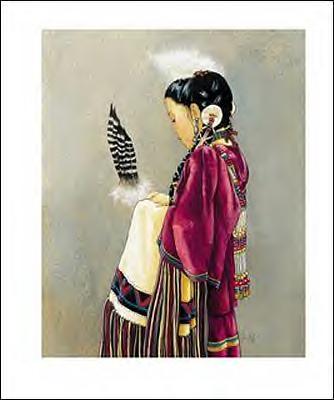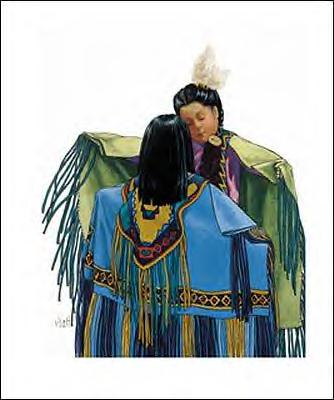|
|
St. Croix Ojibwe Youth Lords of Dance The Official Website of the World Eskimo-Indian Olympics\ Indian Country Wisconsin-Ojibwe Wisconsin Ojibwe
by Gary Dawson http://www.duluthnews.com
 HERTEL,
Wis. -- Accustomed to the more stationary or straight-line dancing of Canadian and Alaskan tribes, the crowds attending
the World Eskimo-Indian Olympics in Fairbanks, Alaska, warmed up quickly to the spirited, swift moving Wisconsin
Ojibwe youths from the St. Croix Band of Lake Superior Chippewa.
HERTEL,
Wis. -- Accustomed to the more stationary or straight-line dancing of Canadian and Alaskan tribes, the crowds attending
the World Eskimo-Indian Olympics in Fairbanks, Alaska, warmed up quickly to the spirited, swift moving Wisconsin
Ojibwe youths from the St. Croix Band of Lake Superior Chippewa.
With rotating circle formations, and toe and heel tapping combined with colorful regalia, the St. Croix Trails
tribal youth dance team from Hertel, featuring boys and girls ages 9 to 17, captured the hearts of the fans and
the judges. When the competition was over last month, the eight dancers and flag carrier representing the band
were named the Best Indian Dance Team for 2000.
"Everybody from your community should be very proud of you. We want you to come back next year,'' Olympics
Board Chairman Greg Nothsine told troupe members when he asked them to come forward and get their trophy.
Dancing mostly against adult teams, the young people say it was an experience they'll never forget. The eight-day
trip included participating in tribal games unique to Canadian and Alaskan native communities, meeting contemporaries
from those tribes and touring breathtaking Denali National Park, which contains the tallest mountain in the United
States, Mount McKinley.
Dancing is not formally taught in the St. Croix band. Youths learn from their families, peers and elders. Many
learn their steps and movements by watching dancers at inter-tribal powwows. Adults offer suggestions for improvement
and assist making intricate regalia that helps tell the story of dances, which may contain one of several themes,
such as hunting or healing. Dancers typically perform at social and ceremonial events.
The St. Croix team was formed in 1996 with the help of human services staffers at the band's Family Resource Center.
The members are part of the center's TRAILS program -- Testing Reality and Investigating Life Styles. About 35
young people are involved, ranging in age from 18 months to 17 years. Adults working with the group include Gloria
Merrill, human services facilitator; Jeff Butler, prevention coordinator; Mark Soulier, TRAILS coordinator; and
Jennifer Greenwald, a University of Wisconsin-Eau Claire senior intern who is majoring in American Indian studies.
"They basically learn dancing on their own; we just provided some coordination and organization,'' Butler
said.
Josh Merrill, 12, son of band Chairman David Merrill, does a traditional dance emphasizing the role of the male
Indian as a hunter and warrior. It includes, for example, looking for signs on the ground, moving slowly to sneak
up on prey and using a feather fan to block the blinding sunlight.
Dusty Soulier, 13, Mark's son, does a fancy feather dance, a more modern dance that originated among southwestern
U.S. tribes. His regalia is ornate, containing colorful feathers, ribbons, yarn, beads and leather. A head roach
is made of porcupine and deer hair.
 Michelle McFaggen, 11, does a fancy shawl dance, featuring the graceful movements of a butterfly.
Michelle McFaggen, 11, does a fancy shawl dance, featuring the graceful movements of a butterfly.
Brandon Geshick's decorative regalia resembles flowing, colored grasses. At age 9, he was the youngest of the dancers
to go to Alaska. He dances one of the oldest styles, intended to represent the flattening of grasses for events
such as powwows.
Carmen Leoso, 16, and her sister, Katrina, 17, do a jingle dance. It is a dance of medicine, healing and praying
for the well-being of others. Their dresses feature 365 metal snuff can covers rolled into 3-inch cones.
Also on the trip to Alaska were Kyle Phernetton, 11, who does grass dancing; Amber Merrill, 13, the Little Miss
St. Croix Wild Rice Princess, who wore a burgundy and yellow dress decorated with sea shells and jingles and a
beaded crown made by her mother; and Tony Duchon, a flag carrier. Amber and Tony are grandchildren of Gloria Merrill.
The youths not only danced, they participated in two types of stick-pull games, including one where the stick is
greased.
"We met a man named Bob Beach,'' said Katrina Leoso. ``He was so nice to us and was with our group all the
time.'' Beach is a disabled Vietnam veteran from the Gwich'in Athabascan tribe of the Alaskan interior. The group
gave Beach an autographed tribal T-shirt for his kindness.
http://www.weio.org/
http://www.mpm.edu/wirp/ICW-224.html
http://www.wisconsintourism.com/History/history8.htm
![]()
|
|
| Canku Ota is a free Newsletter celebrating Native America, its traditions and accomplishments . We do not provide subscriber or visitor names to anyone. Some articles presented in Canku Ota may contain copyright material. We have received appropriate permissions for republishing any articles. Material appearing here is distributed without profit or monetary gain to those who have expressed an interest. This is in accordance with Title 17 U.S.C. section 107. |
|
Canku Ota is a copyright of Vicki Lockard and Paul Barry. |
|